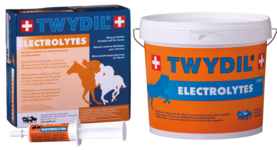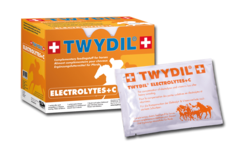Sodium (Na)
Fifty % of the body’s sodium is found in bones. The other part is used to regulate the hydro-electrical and acid-base balances within the body. It is mainly extra-cellular. The main losses occur through milk, urine and sweat. Sodium is also stored in the large intestine.
Electrolytes and their roles:
- Stimulation of thirst (rehydration/renal function)
- Regulation of nerve impulses (balance of electrical charges)
- Regulation of muscular contraction/relaxation cycles (lack of electrolytes =>myopathy)
- Involvement in blood coagulation
Pay attention, a single excessive dose may induce stomach ulcers.
A lack of muscle relaxation can be induced by a hydro-electrical unbalance.

Electrolytes and rehydration:
Electrolytes loss in sweat in the healthy adult horse is essentially linked to the work load, temperature and humidity.
In extreme conditions a horse may lose up to 12 litres of sweat per hour. (Weigh your horse before and after effort!)
Sweat composition:
- Sodium (3.1 g/l)
- Chloride (5.3 g/l)
- Potassium (1.6 g/l)
- plus calcium, magnesium, phosphate,…
Feed can compensate for some electrolytes losses:
- Forage is rich in electrolytes
- A salt block furnishes an average of 10 g of salt per day (just enough to cover the needs for a horse at rest)
- Additional electrolytes must be given after heavy exercise or in hot conditions.
For a good use of electrolytes in horses
Regulation of nerve impulse (balance of electrical charges):
The risk of accident is increased if the horse is dehydrated, because of a lack of water but also of electrolytes.


